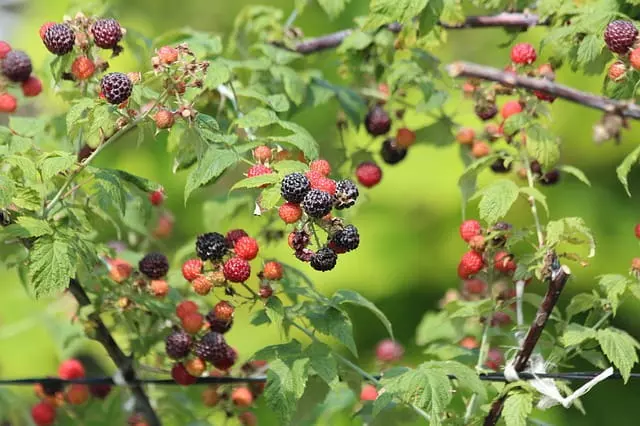Raspberry or scientifically known as Rubus idaeus, is a small perennial shrub of the genus Rubus. It has its origin in Europe and northern Asia, although it is currently cultivated throughout the world. Undoubtedly this shrub owes its popularity to the fruit it produces. The fruit has a rounded or conical shape with red skin and fine hairs. In this article, we will study everything about how and when to prune raspberries, and we will also take the time to analyze how to prune them correctly.
Table of Contents
How to Trellis Raspberries
If you have read more articles on this site you will have seen that we usually start our articles by giving the basic care of the plant in question. In the case of the raspberry, we have decided to replace that section to focus on single care, the staking.
Although all raspberry varieties develop their shoots erect, they need a structure to keep them upright, especially at harvest time. Without such a structure, and with the weight of the production, all the branches would collapse and many fruits would end up on the ground. Therefore, training should be carried out to improve growing and harvesting conditions.
There are many varieties of raspberries, so we will analyze their training and pruning in two main groups:
- Re-flowering varieties: these are the most used nowadays since they are capable of giving two harvests in the same year. One of them is in late summer and early autumn and the other in the spring-summer season of the following year.
- Non-re-flowering varieties: this second group is characterized by giving one harvest per year. This harvest takes place in summer, on the branches that have grown the previous year. The stems are biannual, since they grow one year to bear fruit the following year, and then dry out.
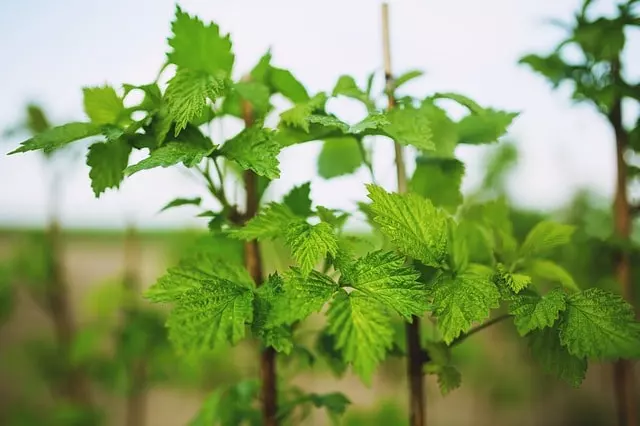
Trellising Re-Blooming Raspberries
In general, these varieties are well adapted to the following training systems:
Hedge: This is a fairly simple structure, consisting of placing poles every 20-26 ft (6-8 m) in the row of raspberries. Two wires are placed in this line of posts, one at about 28″ (70 cm) and the other at 59″ (150 cm) from the ground. The idea is that the raspberry canes or shoots are “squeezed” between the two lines of wires. This makes the task easier as there is no need to tie the shoots to the wires.
V” system: This structure consists of wires that are placed in inclined planes forming a “V”. This can be achieved with two lines of poles placed at an incline, or with vertical poles and two crossarms. The idea is to tie the productive canes of the raspberries on both sides of the “V”, leaving the center free where new shoots develop. This structure facilitates sun exposure, pruning, and harvesting.
Trellising Non-Re-Blooming Raspberries
For this second group, fan trellising can also be used, although trellis trellising may be cheaper.
Trellis: this is one of the most classic structures in raspberry trellising. Posts are placed every 20-23 ft (6-7 m), with 2 or 3 lines of wires. The first line is placed at 20-28″ (50-70 cm) while the last one is at about 5-5.5 ft (1.5-1.7 m). The productive branches are then tied to the wires.
Tools For Prune Raspberries
We can mention the following tools and/or materials necessary for pruning raspberries:
Pruning shears (Order here).
Ladder. We recommend this super light ladder for pruning (Order here).
Gloves (Order here).
Keep in mind that you must disinfect all cutting tools before pruning. This will help to avoid transmitting diseases, you should do it before starting pruning and every time you change plants.
How And When to Prune Raspberries
If we want a good harvest of raspberries in our orchard, pruning is a fundamental element. There are several reasons why it should be carried out, among the most important are:
- Renews the plant.
- It controls the development.
- Achieves the adequacy of the plant to the support structure.
- It improves the aeration and density of shoots, which reduces the presence of fungi.
- Makes harvesting easier.
To analyze how to prune raspberries, we will divide the analysis between re-flowering and non-re-flowering varieties. Although before that it should be clarified that regardless of the variety both need pruning in repotting it, the same consists of cutting the plant to about 8″ (20 cm) of soil.
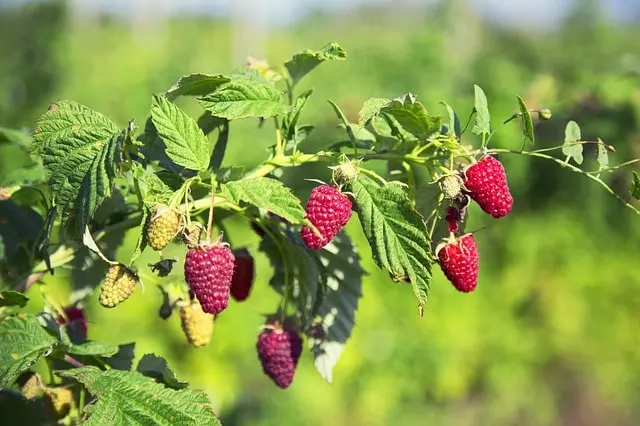
Pruning Re-Blooming Raspberries
To prune correctly you must understand where each of the two productions is generated:
- Late summer/early fall production: this occurs in the upper third of those shoots developed in the spring of that year.
- Spring-summer production: this is generated in what is left of the cane or bud that did not fructify last year.
Having understood this, you should also know that you can prune in a way that allows you to obtain these two harvests, or you can carry out a pruning that only gives you an annual harvest. This last case is very frequent when the raspberries go to a processing industry, and the harvesting is done mechanically.
If you want to take advantage of the two harvests that this variety can give you, you should prune the raspberries in the following way. The first pruning is done after the first harvest, here we will cut the branch just below the last fruit, leaving the rest of the shoot. That part of cane that we leave will be responsible for giving new fruits, once harvested we will cut them at ground level. You must be careful and, in this pruning, only cut the branches that have just produced, leaving those new shoots that will produce in late summer.
For a better understanding, I leave the following chronological scheme of this pruning.
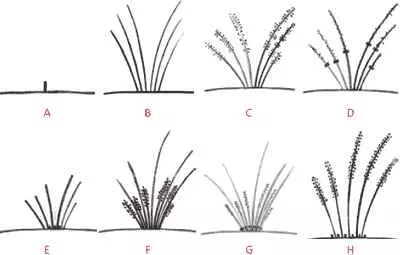
Pruning scheme of flowering raspberries for two annual harvests.
A.- Planting.
B.- Shoot development in spring-summer.
C.- Late summer production.
D.- Finished late summer or early fall harvest and pruning on the part that has produced.
E.- Branches after fall pruning.
F.- Spring-summer harvest begins on last year’s branches, along with this new growth develops.
G.- Cutting at the ground level of those canes that have finished the spring-summer harvest.
H.- Begin harvesting in new shoots at the end of the summer, thus closing the cycle of a re-flowering variety.
If you are satisfied with an annual crop, pruning is even easier. Pruning should only be done in winter at ground level, once the harvest is finished. This way you will only have the end of summer production.
Pruning Non-Re-Flowering Raspberries
As we said, this variety only gives an annual crop, which is produced on the canes of the previous year. Pruning should be done once the raspberry harvest is finished, approximately in mid-summer. It is at that time that we will cut at ground level all those branches that have been produced.
The previous pruning is the most important pruning that cannot be missed. But also in winter, a cleaning pruning can be done, cutting those weak or dry shoots and leaving the strongest ones. Depending on the type of supporting structure, a certain number of canes per meter should be selected and left, but it generally varies between 8-12 branches per meter. The selected branches are then tied to the wires and blunted.
As in the previous section, we leave a scheme for better understanding.
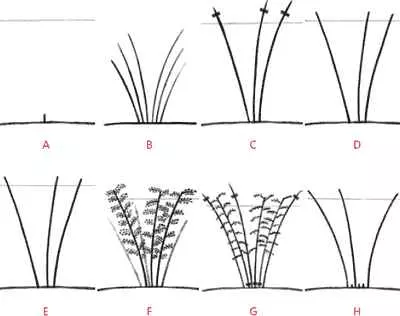
Pruning scheme of non-re-flowering raspberries.
A.- Planting.
B.- Shoots developing in spring-summer.
C.- At the end of summer, the shoots are pruned above the last wire.
D.- Canes that during the winter are tied to the wires.
E.- Beginning of the second year before the beginning of sprouting.
F.- Canes in production during the summer and at the same time new shoots are growing.
G.- Once the harvest is finished, the branches that have been produced are pruned and the rest are left and selected.
H.- Branches in winter are tied to the wires and end of the cycle.
We hope you found this article on how to prune raspberries useful. We recommend our article on how to grow raspberries step by step.
